my experience is different. Audacity sucks eggs. CoolEdit pro is good and I use it frequently, though it doesnt do 24bit DSP as it renders in 16bit of 32bit floating and I dont have a 32bit soundcard. Do you? Dont get me wrong 16bit is OK, but its got a long way to go until i buy in.
Personally I dont think the DSP VSTI plugins are in general that hot, and theyre far from modern since CEPro must be a decade old now. That being said, I will have to search out those Aurora. The pessimist in me doesnt have that much confidence in them though.
Personally I dont think the DSP VSTI plugins are in general that hot, and theyre far from modern since CEPro must be a decade old now. That being said, I will have to search out those Aurora. The pessimist in me doesnt have that much confidence in them though.
Last edited:
Cool Edit Pro 2.1 certainly does 32 bit; and 32 floating point; user bit depth conversion with dither options. I do all filter work from editor; but multitrack will do 32bit integer mix. Sourceforge Convolver works 32bit, 24bit, 16bit.
Convolver in Windows Media Player, and under VST host will operate bit perfect.
Regards,
Andrew
What? With steeper crossover filters, it is possible to safely cross tweeter much lower, reducing beaming issues of mid/woofer.
Convolver in Windows Media Player, and under VST host will operate bit perfect.
Regards,
Andrew
Active does not solve beaming problems of running drivers too high and used rashly encourages sudden changes in polar response, even though on axis measurement is ruler flat. It does allow better designs with already well chosen drivers
What? With steeper crossover filters, it is possible to safely cross tweeter much lower, reducing beaming issues of mid/woofer.
interesting...im still discouraged by 16bit being the best my 24bit SFX card will output. Im certain 32bit would be worth the effort, IF i had a capable card. Although my home studio efforts have sounded great so perhaps 16bit is sufficient? Damn now i have to buy another amp and/or soundcard to try that VST...
I'm not sure how you are coming to 16bit limit with 24bit card. 32bit processing makes sense for computation, but 32bit output is waste, and nobody to my knowledge is achieving this sort of performance. Thermal noise of most resistors at room temperature result in dynamic range less than 24bits; speaker drivers are much worse than this. Most speaker systems don't effectively show better than 12bits. Most people don't have clue as to how much sound is on a well produced CD.
Regards,
Andrew
Regards,
Andrew
And then there's microphones . . .Thermal noise of most resistors at room temperature result in dynamic range less than 24bits; speaker drivers are much worse than this.
I used to obsess about the last half dB of microphone noise . . . until I realized that once the orchestra was seated and breathing I couldn't hear it . . .
24 bit is good for capture . . . it makes life much easier setting gains and avoiding impulse overload. 32 bit is necessary for processing. 16 bit is plenty for delivery . . . anything more is wasted overhead or lost in the noise.
The beaming aspect is true of both types of XO's ... and if used rashly, both will hurt polar responses. ... but as Barleywater pointed out, correctly chosen steeper filters will/should improve polar response both on and off axis. That that should allow for better designs with even not so well chosen drivers.Active does not solve beaming problems of running drivers too high and used rashly encourages sudden changes in polar response, even though on axis measurement is ruler flat. It does allow better designs with already well chosen drivers
Within reason, yes, but not for cheap tweeters or something like the Tekton 10" thread in this forum.What? With steeper crossover filters, it is possible to safely cross tweeter much lower, reducing beaming issues of mid/woofer.
flavio, analogue active is the direction im more comfortable following. DSP is touted as a panacea for all ills. With passive and analogue, I at least know what colourations to expect, and so does my ear. The ear ignores many flaws but pre-ring is a concern with convolution. Its not a natural distortion, and the ear will detect it easier than other distortions, though at what level is subject to debate.
A lot of discussion about DSPs, A/D and D/A around here, but most of the advantages of going active will also be realized by using analog crossovers too, particularly 4-th order ones (or steeper)
Most of advantages of DSP are lost when used only to emulate basic crossover functionality possible with passive components. Please review post #347.
Going beyond 4th order passive is plagued by reactive behavior of drivers and insertion loss. Going beyond 4th order analog active begins to push realistic demands for component matching to obtain targeted filter responses.
Regards,
Andrew
....The ear ignores many flaws but pre-ring is a concern with convolution. Its not a natural distortion, and the ear will detect it easier than other distortions, though at what level is subject to debate.....
Debate of pre-ringing as seen in time domain of linear phase filters stems from misunderstanding of fundamentals with continuous time v discrete time systems, and stems from lack of attention to detail in generation and manipulation of filters as represented in time domain. Correction of group delay inherent in capacitor coupled electronics and in speaker drivers leads to observable pre-ringing structure. Convolution of proper inverse results in perfect IR. However, reflections captured in IR measurement of real system also translate into pre-ringing, and this is major source of different implementations in "room correction" software. Efforts to get one size fits all type solution with single measurement from preferred listening position is problematic, and thus many approaches.
A proper inverse for minimum phase response may be transformed into a minimum phase filter, with zero pre-ringing. Convolution with basis IR results in flat spectrum, but resultant IR is minimum phase replete with group delay and associated phase behavior.
Audibility of steep crossover linear phase filter is virtually identical to high order minimum phase filter. Acoustic centers distance v crossover frequency is the culprit impacting off axis behavior. Poor design choices lead to poor results.
Yes, auditioning a steep crossover filter by solo listening to its IR may present as horrible ringing, but this is out of context of filter applied to continuous time signal; and with its conjugate also operating.
This is not debate or vague regurgitation of others work, but my results from hundreds of hours experimentation based on academic study.
As Coppertop has found, and many others too, initial results with most software packages tend to be awful, but tends to stem from poor measurement technique, and to gaining understanding of software control parameters.
Regards,
Andrew
Most of them, I'm sure. After a brief flash and puff of smoke, of course!
No smoking: Peerless 830970 2" 4ohm driver
Test stimulus is band pass 1.5kHz-1.7kHz burst:
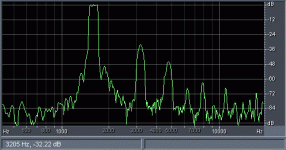
2nd harmonic comes in at about 2.5% using signal that has 120v p-p maximum.
I come up with instantaneous power of about 450watts. The stapedius and trigeminal muscles don't finish contracting until after burst, causing room sound to momentarily dim. Wine glasses at 5 meters ring.
When abuse is repeated with burst centered at 6kHz, 2nd harmonic drops to about 0.5%
Both bursts are summed, 120v p-p maximal signal applied and nice display of intermodulation distortion results:
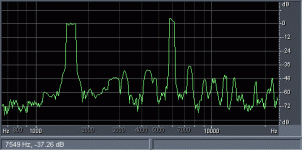
Under controlled bandwidth conditions, driver exhibits order of magnitude cleaner performance than compression drivers.
Regards,
Andrew
Thanks for the tests. Nice little drivers. I don't think I'd call them tweeters, exactly, but they could be used that way. I have a pair of the Vifa TC9FD18-08 3.5" FR that also serve well as big tweeters. I would not try to run them long at 450W, but they are more rugged than the typical dome tweeter. 
And speaking of rugged dome tweeters, I've run the ScanSpeak 3806 for years and really like it. It's the Mack Truck of dome tweeters, but gets the job done. Matches very well with most 12" woofers. Some call it a mid-tweet, which might be more accurate. A great driver.
And speaking of rugged dome tweeters, I've run the ScanSpeak 3806 for years and really like it. It's the Mack Truck of dome tweeters, but gets the job done. Matches very well with most 12" woofers. Some call it a mid-tweet, which might be more accurate. A great driver.
Andrew,No smoking: Peerless 830970 2" 4ohm driver
Test stimulus is band pass 1.5kHz-1.7kHz burst:
View attachment 312274
2nd harmonic comes in at about 2.5% using signal that has 120v p-p maximum.
I come up with instantaneous power of about 450watts. The stapedius and trigeminal muscles don't finish contracting until after burst, causing room sound to momentarily dim. Wine glasses at 5 meters ring.
When abuse is repeated with burst centered at 6kHz, 2nd harmonic drops to about 0.5%
Both bursts are summed, 120v p-p maximal signal applied and nice display of intermodulation distortion results:
View attachment 312279
Under controlled bandwidth conditions, driver exhibits order of magnitude cleaner performance than compression drivers.
Regards,
Andrew
Could you explain how you arrive at an instantaneous power of about 450 watts from a signal that has 120v p-p maximum?
How was the 120v p-p maximum measured?
What is the SPL of the above test?
Could you post an exhibit of a compression driver at the same SPL and the resultant distortion?
Art
nice tests, seems those small wideband drivers arent bad at all. On the topic of the thread I have come up with the simplest active solution that i can try. Using a GEQ3102 and the variable butterworth 2nd order low cut 10-400hz for widerange driver filter, and an additional subwoofer amp module. Trouble is finding such an amp with a similar range of turnover frequencies and slope. Once im paid it may be worth a shot.
Any suggestions for the sub amp?
Andrew I follow most of which you speak, and I do not diasgee. The problem for me is that I do not wish to spend the same length of time as you have, in order to eliminate preringing in my home stereo. Is all of that possible to the layman, without a doctorate? If so then great, if not then id rather stick to the evils i understand and can tackle, rather than implement a DSP solution which may be beyond My capability to resolve to my satisfaction.
Any suggestions for the sub amp?
Andrew I follow most of which you speak, and I do not diasgee. The problem for me is that I do not wish to spend the same length of time as you have, in order to eliminate preringing in my home stereo. Is all of that possible to the layman, without a doctorate? If so then great, if not then id rather stick to the evils i understand and can tackle, rather than implement a DSP solution which may be beyond My capability to resolve to my satisfaction.
Last edited:
Good question, it seems that at 4 ohms it would be much more.Could you explain how you arrive at an instantaneous power of about 450 watts from a signal that has 120v p-p maximum?
Another good question.How was the 120v p-p maximum measured?
Andrew,
Could you explain how you arrive at an instantaneous power of about 450 watts from a signal that has 120v p-p maximum?
How was the 120v p-p maximum measured?
What is the SPL of the above test?
Could you post an exhibit of a compression driver at the same SPL and the resultant distortion?
Art
The two burst signals centered at 1.6kHz and 6kHz have a windowed sinusoidal form in peak region:
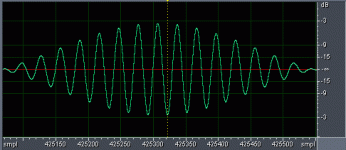
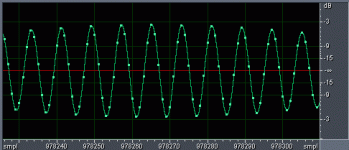
Above pictures are of recorded terminal voltages.
Some details:
Square driver flange is milled round for mounting into end of 2" ID PVC pipe that is 12" long. Pipe is stuffed with Dacron, and other end is left open.
Calibration is accomplished by playing 60Hz sine with amplifier (Hafler Pro2400 running bridged) output unloaded and adjusting output level with voltmeter to reading of 44.7v RMS via volume pot of E-MU 0404 USB. This is peak voltage +/- 63.2v.
Fostex FR-2 is used for capture. Hot and cold phases are connected across output of amplifier at end of speaker wire with 44.7v RMS signal, and FR-2 input attenuator is adjusted for signal peak of -3.0dB. This is monitored in DAW software, Sonar LE, by connecting FR-2 digital out to E-MU 0404 USB soundcard.
In previous similar studies a DC coupled and calibrated oscilloscope was used in conjunction with above methods and equipment for validation purposes.
From recorded terminal voltage peaks (+/-) at center of waveform, -3.4dB is seen, corresponding to +/- 60.37 volts. Extrapolating this as true sine, this is divided by 2^0.5 for RMS voltage of 42.69 volts. Squaring this and dividing by 4ohms yields power of 456 watts.
In reviewing calculation, 4 ohms is underestimate of driver impedance at 1.6kHz and at 6.0kHz. Working from impedance plot in manufacture driver specifications, these are better taken as 4.7ohm and 6.0ohms respectively, yielding a mere 388watts for 1.6kHz bursts, and 304watts for 6kHz bursts.
For combined signal burst, power bandwidth is split roughly in half (-6dB)to each of the signal bands. If I had 1kw amplifier kicking around, I'd try it.
I did not reference acoustic response for 1watt input, but driver specification is 82dB/1watt. This is horrible compromise made for size, cost, and intended applications. Nonetheless, at 388 watts this is 2^8.6 over 1watt or 6dB x 8.6 + 82db = 133dB estimated SPL. Throw in a little tiny bit of power compression and peak SPL is still likely very high.
Normally I run this driver crossed at 1kHz with Hafler Pro1200 in stereo mode. Amplifier is conservatively rated, and rail voltages are relatively high for spec. Transformer, power caps, and 1 pair output mosfets limit, but for my application provide nice headroom for transients. I like symphonic music where each instrument sounds live. Full orchestra peaks are known to be 100-110dB at conductor's position. Uncompressed recordings are awesome.
I don't own any compression drivers, but have down loaded mp3 results from your previously posted links, and what I see is not impressive for domestic settings/critical listening, and is stock and trade performance for PA sound.
I will happily upload burst stimuli of requested band widths for anybody interested in running tests similar to these. All flavors of format are possible, excluding 64bit stuff, which is completely unnecessary.
My above posts are preamble in continuing with topic: Active v Passive. The above methods are employed.
High pass crossover performance is analyzed starting with brick wall low pass filter set to intended corner frequency of high pass filter being studied.
Peerless 830790 is billed as full range driver. High powered testing as above indicates driver is relatively immune to failure under adverse conditions, and 1kHz 24k point FFT low pass filter (LP1kFIR24k) bursts didn’t destroy or otherwise appear to harm it even with maximal signal. In this case function follows windowed sync filter and single cycle maximal voltage swings from –13v to 60v. Frequency response below 1kHz appears much as swept sine results with small signal, but above 1kHz a large output is seen:
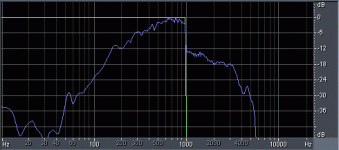
Above picture of test spectrum and of result spectrum both are 1kHz referenced to –6dB. Clearly the driver is not able to handle signal without lots of distortion.
Next results show band passed burst 430Hz to 1kHz with 24k point FFT filter (BP430-1kFIR24k) also with 1kHz referenced to –6dB:
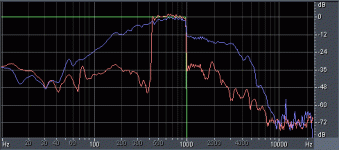
Performance is greatly improved, but stop band <430Hz and >1kHz rides in –36dB zone. This isn’t noise floor, but sea of distortion components as sums and differences of fundamentals and their harmonics. Noise floor is effectively around –72dB.
The maximal voltage swing is –46v to 60v. Sound is short, loud, and produces sensation similar to slapping palm of hand against ear. Ouch.
Above results set groundwork for investigating performance of 1kHz high pass crossover filters.
....Which will follow shortly.
Last edited:
- Status
- This old topic is closed. If you want to reopen this topic, contact a moderator using the "Report Post" button.
- Home
- Loudspeakers
- Multi-Way
- Active vrs passive